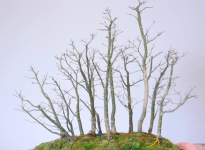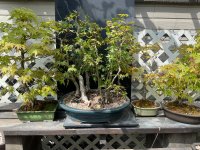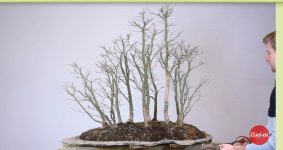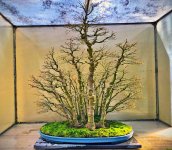Normal repot for a group is treat the entire group as a single tree- cut around the perimeter and maybe 1/3 off the bottom of the root ball then repot with fresh mix.
It is always possible to separate individual trees from a group. You may need to cut some substantial roots as the roots will be very well entwined.
Renovation often only requires the group to be separated into sections with several trunks in each section so less invasive than separating every trunk. You can see that procedure in the video.
Depending where the new trees need to go you might be able to chop enough roots out of the existing group to insert your new trunk(s) but the trees either side appear substantial. If they are to go into that group I suspect you'll need more than just a couple of small holes. Need to work out roughly where the new trees will fit and whether repositioning or turning any of the existing trunks is required to give a better result. Then plan where to make the cuts to separate clusters or individual trees to achieve the result you want.
I’m a little confused with some of the things he’s doing. It seems like the trees were planted in a mostly organic mix - is that because it’s on a slab? Then he trims some rootballs and fills in the gaps with, maybe pumice? He doesn’t add any trees, but maybe he re-positioned the ones he worked on - it was hard to detect much change. Was he only repotting 1/3 of the forest at a time for some reason, or was the video just to show how to make slight changes?
Not repotting just 1/3 of the forest. The video shows repositioning the other 3 trunks at the right a little further to the back and moving another tree from the rear to the front. Sometimes small changes can make a big difference in how we see a bonsai. He also adds a new tree into the back of the group. You can see the beginning of root pruning a pot shaped root ball but the film misses the part where a new hole is created in the rear of the group planting for that tree to fit in.
Here I've marked the changes in the photos above.


Blue arrow shows the new tree inserted at the back.
Orange shows the tree that was moved from rear to front.
Red marks the group of 3 trunks that was turned and moved a little to the rear.
Not huge changes. The space seen between trunks through to the distance has moved from dead centre to centre right. Trees at right that were almost behind another is now fully visible. (not sure that's an improvement?)
Not sure if the original soil is organic or whether it has just decomposed enough to appear that way. Fertiliser, decomposing roots and leaves and even airborne dust seems to add organics to any mix over time. It may also be that he's taking the opportunity to slowly change soil from an original organic mix to more inorganic.
Trees on rock slabs definitely dry out way more than similar trees in well fired pots. I've found it much better to use a higher organic mix when planting with rocks of any sort.










